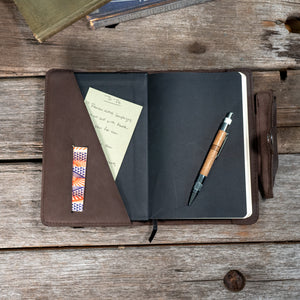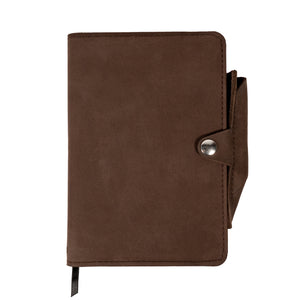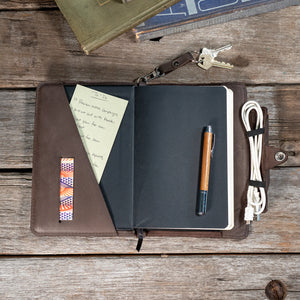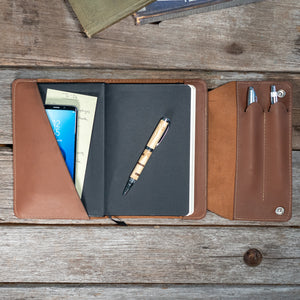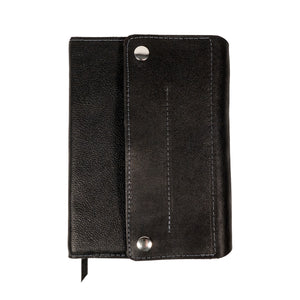Leather Journals: All the options and how to find the best one for you.
There's nothing that beats the feeling of cracking open a leather journal to capture your thoughts. We all started with simple notebooks, but as we look for better options what are the important things to look for? Whether you're new to journaling or have been doing it for years, this article will help you find the best quality leather journal for your needs.
What Makes a Journal a Journal?

In the loosest sense possible, anything can be a journal, depending on how you use it. Some people reach for spiral or composition notebooks. As long as you use it to write down ideas and thoughts, it counts as a journal.
As loose as that definition is, there’s actual technical industry jargon here too. Journals usually use a paper size called A5. A page of A5 is 5-7/8 x 8-1/4 in (148 x 210 mm). For those of us who don’t want to pull out a ruler to measure a page, that’s roughly the size of a letter sheet (standard printer paper) folded in half. If you are writing on bound sections of A5 paper, you’re writing in a journal.
Should You Pick a Refillable or a Leather Bound Journal?
Deciding between a refillable or bound journal? Here are a few aspects of your journal that can help you pick which one is right for you.
Sustainability
There’s no way around it—leather comes from animals, and as such we should respect that and use it only to make long lasting muti-use products.
Refillable journals help by extending the lifespan of the journal past a single use. Instead of having to buy more leather journals each time you fill up the last page, you only have to replace the pages, and you can continue to use the same quality leather journal.
Paper Quality

Three popular A5 journal refills from well known brands. Rhodia, Leuchtturm, and Moleskine
Not all paper is the same, and for serious journalers, you know how much the paper’s quality, thickness, and weight impacts the writing experience.
Bound journals often have to compromise on paper quality, leather quality, or both to meet a price point that makes sense for a single use product. Because there are so many high quality A5 journals that aren’t leather bound available they need to compete on price. This is why we recommend instead finding a high quality journal you love and purchasing a compatible leather cover.
Features
Single-use journals are unlikely to have any storage options or additional features because they’re designed for temporary use—the bells and whistles aren’t worth the cost for a product that will only be used for a few months. Refillable journals often come with internal bookmarks and storage spaces for you to keep track of spare pens, refills, notes, and any additional paper you need.
Price
Single-use journals will typically be cheaper than a luxury leather journal and your first refill. For this reason, if you’re not much of a writer or you don’t plan on using the journal much, it might make sense for you to go the cheap route.
But what if you’re in it for the long haul, with years of journaling ahead of you? In a single moment, the single-use journal is generally cheaper, but over time, the refillable journal takes the lead. Paper refills cost less than even a cheap single-use journal.
The more you write, the more cost-effective a refillable journal becomes.
Does Leather Type and Construction Quality Matter?

An example of the difference in leather quality.
A refillable journal is an investment that will stand the test of time. But only if it's made with quality materials and craftsmanship. Over time, a well made journal only becomes more meaningful with each use.
Journal quality starts with the leather. Leather is a complicated topic to tackle because there are tons of confusing buzzwords companies use that don’t really mean anything. Even industry terms like “full-grain,” “top-grain,” or “genuine leather” can be inflated and manipulated. Different areas of the world try to claim their leather is superior to others, but there’s no evidence of this because cows are cows no matter where they are from. It’s the process that makes high-quality leather, not the place.
To help you cut through all of the confusion of what is or isn’t good leather, here are a few questions you can ask to help you find a quality journal.
- What type of leather is used? Terms like “full grain” and “top grain” generally mean you’re dealing with higher quality leather. But the term alone isn’t enough. Look into other details too. Avoid anything that uses “genuine leather” or “bonded leather” completely. These are made from the waste products after producing full and top grain leathers.
- How thick is the leather? As long as the leather is coming from the same species of animal, and not a waste grade, thicker leather will last longer. Thickness can be measured in millimeters or ounces. Generally, anything under 3-3.5 oz isn’t going to last, regardless of the buzzwords attached. Here’s a chart to help you better understand what different thicknesses of leather are used for and how to convert from ounces to millimeters of thickness.
-

Thread quality is key to a long lasting journal.
Which thread is used? Thread holds your journal together. It doesn’t matter how great your leather is—if you are using weak thread, the journal will fall apart after only a few years of use. The easiest way to judge the thread is to ask the maker for the Tex number. This number is a universal number used in manufacturing. Higher Tex numbers are better for journals, so look for a Tex number of at least 50, or the thread will fail before the leather does. If your manufacturer cannot provide you with a Tex number, that should be a red flag because that’s like a chef not wanting to tell you how fresh their fish is. It’s also a good idea to avoid cotton thread regardless of Tex Number. - Is there lining material? What is it? The lining isn’t going to see as much wear as the outside leather cover, but it can still break down and shorten the lifespan of your journal. Beware of cheap synthetic fabrics like polyester. Leather will generally outlast any fabric, and it’s a good idea to go with a full leather journal for the most durability. There are some designs, however, that require lining. At Allegory, we use a heavy cotton bull-denim material that can hold up to heavy use and often last as long as leather.
Ideas to Use Your Leather Journal.
You can use refillable leather journals for anything that involves writing or drawing. With a wide range of custom inserts, you can use the same leather journal to write a short story or plan the next month of your life.
Here are just a few of the ways you could use a leather journal:
- Bullet Journaling
- Daily stream-of-consciousness journaling
- Creative writing
- Sketching
- Designing
- Outlining
- Writing a diary or memoir
- Taking notes for a class or meeting
- Mindfulness journaling
- Tracking your diet or fitness journey
- Improving mental health with a gratitude journal
- Tracking and managing personal goals
- Improving communication skills
- Drawing
- Keeping a dream journal
- Doodling
- Scheduling your day, week, or month
Start Journaling with the Best
We’ve made finding the best personalized, refillable leather journals easy. At Allegory, we specialize in handmade leather journals that are sure to last. We guarantee our products for life. We will repair or replace anything. There’s no paperwork needed or questions asked. Upgrade your journal today.




